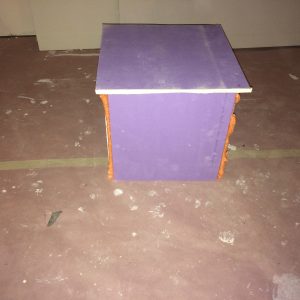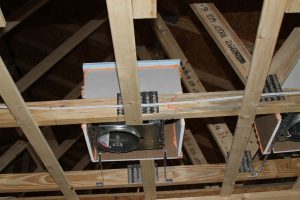Fire-Resistant Drywall
By Myron Ferguson
The other day I was giving a demonstration on air sealing an attic. I built a box out of drywall scraps to use as a cover for recessed ceiling lights. This box would be fitted so that it sets tight against the drywall ceiling in the attic. It would then be sealed airtight with foam or caulk to the ceiling drywall, thus isolating the ceiling light and actually making it a part of the conditioned space below. Someone commented that it was good idea especially because all drywall is fire-resistant. The box I made was made out of mold-resistant drywall and not fire-resistant drywall but I pointed out that it is true all drywall has a naturally occurring fire resistant core. This exchange reminded me of some research I did a few years ago. I think it is very interesting and just proves that my method of building the “isolation boxes” out of scrap drywall is a good idea. I do recommend using fire-resistant drywall foamed together and sealed with a fire rated foam or caulk for a best practice. (In one of the photos I used extruded foam for the top cover of the box, for some added R value.)
Regular drywall has a now combustible core. Often referred to as gypsum board it gets it naturally occurring fire resistance from the gypsum core.
Gypsum naturally contains about 21 percent water. When gypsum bd is exposed to fire or heated, the water is slowly released as steam, effectively retarding heat transmission. The chemically combined water being released as steam acts as a thermal barrier until this slow process, known as calcination, is completed.
The temperature directly at the plane of calcination is only slightly higher than that of boiling water (212 F) which is significantly lower than the temperature at which steel begins loosing strength and wood ignites.
Once calcination is complete, the calcined gypsum continues to act as a barrier for the underlying structural members from direct exposure to flames. However in regular gypsum bd shrinkage occurs because of the loss of water volume and cracks occur which permit passage of fire and heat and this can lead to the gypsum falling apart.
Fire-resistant drywall has special additives and noncombustible fibers in the core that help maintain the integrity of the gypsum core as water is lost while providing greater resistance to heat transfer.
Type X Fire-resistant Gypsum Bd must comply with ASTM C1396 and provide at least a one hour fire-resistance rating for 5/8” bd or a ¾ hour fire-resistance rating for ½” bd.
Type C Fire-resistant Gypsum Bd has an improved formulation that exceeds ASTM requirements for Type X. Some brands have a core additive which expands when subjected to heat which aids in holding the gypsum bd together.
Fire-resistance refers to the ability of an assembly to serve as a barrier to fire and to confine its spread to the area of origin.
A fire-resistance rating denotes the length of time a given assembly can withstand fire and give protection from it under precisely controlled laboratory conditions. (In order to attain fire-resistance ratings, the construction of all such assemblies must be consistent with the assembly tested). In other words if the gypsum bd is not properly cut, fitted, attached, and finished it may not meet the desired rating.

